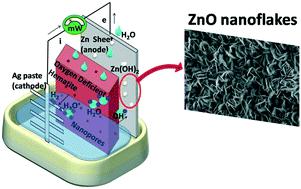当前位置:
X-MOL 学术
›
React. Chem. Eng.
›
论文详情
Our official English website, www.x-mol.net, welcomes your
feedback! (Note: you will need to create a separate account there.)
ZnO nanoflakes self-assembled from the water splitting process using a hydroelectric cell
Reaction Chemistry & Engineering ( IF 3.4 ) Pub Date : 2022-05-17 , DOI: 10.1039/d2re00094f Jyoti Shah 1 , Abha Shukla 1 , Manoranjan Kar 2 , Govind Gupta 1 , Shipra Jain 1 , R. K. Kotnala 1
Reaction Chemistry & Engineering ( IF 3.4 ) Pub Date : 2022-05-17 , DOI: 10.1039/d2re00094f Jyoti Shah 1 , Abha Shukla 1 , Manoranjan Kar 2 , Govind Gupta 1 , Shipra Jain 1 , R. K. Kotnala 1
Affiliation

|
Self-assembled ZnO nanoflakes grown at the zinc electrode of a hydroelectric cell by water splitting have been analyzed. ZnO nanoflake growth in the hydroelectric cell is a facile and cost effective green technique compared to other chemical synthesis processes. The formation of ZnO nanoflakes in the hematite based hydroelectric cell does not involve any template/capping agent/acid or base but only a few ml of water. The hydroelectric cell consists of a nonporous and oxygen deficient hematite pellet attached with the zinc anode and the silver inert cathode on opposite faces of the hematite square shaped pellet. The dissociation of water molecules into H3O+ and OH− ions occurs spontaneously on surface Fe cations and surface oxygen vacancies on hematite. The electrochemical reaction of water dissociated OH− ions with the highly active Zn anode produces Zn(OH)2 nanoparticles. It forms self-assembled zinc hydroxide nanoflakes from the green electricity source hydroelectric cell. Dehydrated self-assembled zinc hydroxide provided highly porous ZnO nanoflakes grown along the preferred (002) polar plane, verified by X-ray diffraction and TEM images. The surface area of ZnO nanoflakes has been obtained (144.28 m2 g−1) using a BET surface area analyser. Surface vacancies and interstitial defects in ZnO have been identified by Raman, photoluminescence, and XPS spectroscopy. The non-stoichiometric surface defects – Zn (Zni), O (Oi) interstitial defects and Zn (VZn), O (VO) vacancies in the ZnO lattice have been reflected in time resolved photoluminescence measurements. Time-resolved photoluminescence spectra analysis showed that Vzn and Vo states are responsible for the blue and green emission. Such defective ZnO nanoflakes may be applicable as photo catalysts under sunlight/visible light due to surface oxygen defects observed by green emission at 540 nm. The self-growth efficient process of ZnO nanoflakes innovated in this work is an easily scalable technique for industrial production possessing huge potential applications in photocatalysis and paper industries.
中文翻译:

使用水力电池从水分解过程中自组装的 ZnO 纳米薄片
已经分析了通过水分解在水力电池的锌电极上生长的自组装 ZnO 纳米薄片。与其他化学合成工艺相比,在水力电池中生长 ZnO 纳米薄片是一种简便且具有成本效益的绿色技术。在赤铁矿基水力电池中形成 ZnO 纳米薄片不涉及任何模板/封端剂/酸或碱,而仅涉及几毫升水。水力电池由一个无孔且缺氧的赤铁矿颗粒组成,在赤铁矿方形颗粒的相对面上附着有锌阳极和银惰性阴极。水分子解离为 H 3 O +和 OH -离子在赤铁矿的表面 Fe 阳离子和表面氧空位上自发产生。水解离的 OH -离子与高活性 Zn 阳极的电化学反应产生 Zn(OH) 2纳米颗粒。它从绿色电源水力电池中形成自组装的氢氧化锌纳米薄片。脱水的自组装氢氧化锌提供了沿优选的(002)极性平面生长的高度多孔的 ZnO 纳米薄片,通过 X 射线衍射和 TEM 图像验证。已获得 ZnO 纳米薄片的表面积 (144.28 m 2 g -1) 使用 BET 表面积分析仪。ZnO 中的表面空位和间隙缺陷已通过拉曼、光致发光和 XPS 光谱法进行鉴定。在时间分辨光致发光测量中反映了 ZnO 晶格中的非化学计量表面缺陷 - Zn (Zn i )、O (O i ) 间隙缺陷和 Zn (V Zn )、O (V O ) 空位。时间分辨光致发光光谱分析表明,V zn和 V o各州负责蓝色和绿色发射。由于在 540 nm 处通过绿色发射观察到的表面氧缺陷,这种有缺陷的 ZnO 纳米薄片可用作阳光/可见光下的光催化剂。在这项工作中创新的 ZnO 纳米薄片的自生长高效工艺是一种易于扩展的工业生产技术,在光催化和造纸工业中具有巨大的潜在应用。
更新日期:2022-05-17
中文翻译:

使用水力电池从水分解过程中自组装的 ZnO 纳米薄片
已经分析了通过水分解在水力电池的锌电极上生长的自组装 ZnO 纳米薄片。与其他化学合成工艺相比,在水力电池中生长 ZnO 纳米薄片是一种简便且具有成本效益的绿色技术。在赤铁矿基水力电池中形成 ZnO 纳米薄片不涉及任何模板/封端剂/酸或碱,而仅涉及几毫升水。水力电池由一个无孔且缺氧的赤铁矿颗粒组成,在赤铁矿方形颗粒的相对面上附着有锌阳极和银惰性阴极。水分子解离为 H 3 O +和 OH -离子在赤铁矿的表面 Fe 阳离子和表面氧空位上自发产生。水解离的 OH -离子与高活性 Zn 阳极的电化学反应产生 Zn(OH) 2纳米颗粒。它从绿色电源水力电池中形成自组装的氢氧化锌纳米薄片。脱水的自组装氢氧化锌提供了沿优选的(002)极性平面生长的高度多孔的 ZnO 纳米薄片,通过 X 射线衍射和 TEM 图像验证。已获得 ZnO 纳米薄片的表面积 (144.28 m 2 g -1) 使用 BET 表面积分析仪。ZnO 中的表面空位和间隙缺陷已通过拉曼、光致发光和 XPS 光谱法进行鉴定。在时间分辨光致发光测量中反映了 ZnO 晶格中的非化学计量表面缺陷 - Zn (Zn i )、O (O i ) 间隙缺陷和 Zn (V Zn )、O (V O ) 空位。时间分辨光致发光光谱分析表明,V zn和 V o各州负责蓝色和绿色发射。由于在 540 nm 处通过绿色发射观察到的表面氧缺陷,这种有缺陷的 ZnO 纳米薄片可用作阳光/可见光下的光催化剂。在这项工作中创新的 ZnO 纳米薄片的自生长高效工艺是一种易于扩展的工业生产技术,在光催化和造纸工业中具有巨大的潜在应用。











































 京公网安备 11010802027423号
京公网安备 11010802027423号